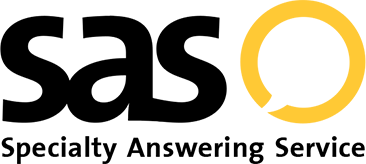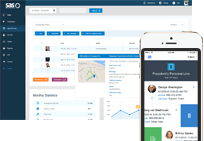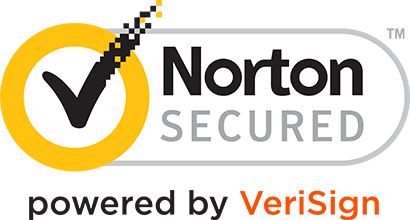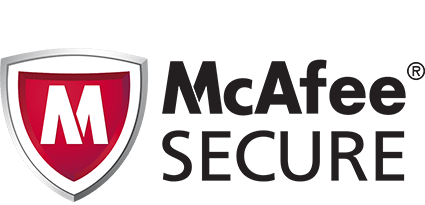- Log In
- Support
- Company
- Contact Us
- Live answers @ 1-888-532-4794
On-Call Definition: What is On-Call and How Do Answering Services Use It?

If you’re not familiar with the lingo, on-call (also spelled oncall or on call) refers to a system or protocol for contacting an employee or group of employees who are available, if necessary, for work and/or communication after business hours. Answering services use on-call systems to deliver messages to specific employees. If you’ve ever called your doctors office after hours, you’ve most likely been exposed to how answering services use on-call schedules – you called your doctor, the phones rolled over to the answering service, the operator ended the call with you and notified the doctor scheduled for that evening that you need a call back, you received a call from the doctor. In a nutshell, that is on-call.
What Industries Use On-Call
Medical professionals and HVAC techs will typically have their answering service use on-call rotations. For medical professionals, doctors are on-call after hours and on weekends, meaning they are available to speak with for medical emergencies. For HVAC technicians, on-call is used to describe the technician available to make an emergency site visit after hours. However, doctors and HVAC technicians are not the only businesses who use on-call rotations. Some examples of other small businesses that rely on on-call systems are:
- Property Management Companies
- Law Firms
- Veterinary/Animal Hospitals
- Locksmith Companies
- Insurance Agencies
- Towing Companies
- Restoration Companies
How Do Answering Services Use On-Call?
Every answering service is different, so how each service manages your on-call data will also vary. For example, some services are able to maintain schedules years out in their software, where others may only accept a singular employee – meaning you need to inform the answering service each time the schedule changes. While the mechanism for how answering services access and program on-call schedules may vary, the premise is always the same. You provide the service with information of who to contact and when to contact them, and they contact your employees when necessary.
Once your on-call data is programmed into the answering service’s system, the agents will know who to contact (the employee on-call), how to contact them (various phone numbers), and when to contact them (only after hours or only in emergency situations). For example, your schedule may show that on Tuesday, Dr. Stacy Brown is on-call from 6:00 PM – 8:00 PM for emergencies. So, any calls received on Tuesday between those times deemed an emergency will be dispatched to her.
Pro tip: Find out from your answering service what phone number messages and calls will be coming from so that you can give your on-call team a heads up. If they do not recognize the number that is calling them, they may miss important phone calls.
Types of On-Call
There are 6 different methods for contacting your employees where answering services can use an on-call schedule, though you are never limited to 1 of these 6 methods. Many businesses will combine some of the below examples to maximize successful contacts with their on-call personnel.
- Warm Patch: A warm patch, also known as a warm transfer, is when the answering service places the caller on hold to reach out to the appropriate on-call person. If the person does not answer, the agent would try another number. If that person does answer, the agent would inform the on-call who is on the other line and why they are calling. They would then transfer that caller through. If that second person did not answer, usually services won’t attempt to call a third number while the caller is still on the line, as they’ve already been waiting on hold for some time. However, if they still need to make contact with someone, they could then go to a reach (see below).
- Cold Patch: A cold patch, or a cold transfer, is similar to a warm transfer except the agent will not call the number first to see if someone is available. They will simply just send the caller through to either talk to the on-call or leave a message if no one answers.
- Reach: A reach on-call occurs after the answering service agent has already documented the necessary information and disconnected from the caller. Since the caller is no longer on the line, the agent can continue to call until someone picks up. If they are calling for a long period of time, usually the reach can be shared among operators so that one agent doesn’t get stuck making all of the outbound calls.
- Email: If your on-call personnel doesn’t wish to receive phone calls, you could just set up an email only on-call schedule that would simply send emails. Some services may send standard emails and some may send them as email to text (meaning that they are sent via a mobile email address but show up as a text message).
- Text: Similar to an email only schedule, a text only schedule would simply just send a text message to the on-call person or group.
- Page: Since paging has become somewhat outdated, not all answering services will offer this feature. However, answering services that cater specifically to medical accounts will probably still use paging as their primary method of reaching an on-call physician.
Does it Cost Extra?
Typically, there is no extra fee to utilize an on-call feature with your answering service. However, depending on how your service bills, you will incur more charges based on the usage that is accrued during the actual on-call attempt. For example, an answering service that bills by the call may charge you for each outbound call they make or each text and/or email they send to reach the on-call personnel.
On the other hand, an answering service that bills by the minute will charge you a per minute rate for each dial out attempt. So, while you may not see an extra charge on your regular invoice, the time spent making the reach outs will be included within your plan’s usage.
On-Call and HIPAA
Since medical offices and hospitals often use answering services to dispatch urgent messages, it’s important to make sure that PHI (private health information) stays protected. Generally speaking, most answering services are HIPAA compliant, so they abide by the regulations outlined by HIPAA. This means that no patient data can be sent via text or email, and no patient information can be left on a voicemail. So, while it does pose some challenges, there are always work arounds.
In regards to messaging, answering services that are HIPAA compliant can either fax messages, or they can give you access to a secure online portal that stores all of your messages in one place. Then they would just send you a text or an email that alerts you of a new message, with instruction to log into your portal. In regards to leaving messages, agents won’t be able to say who called or what it was about, but they can either leave a call back number so you can contact your answering service back to retrieve the information, or you can just log into your portal for the details.
Problems You May Encounter Working With On-Call Schedules
- Forgetting to Update the Schedule: If you forget to update the on-call schedule, chaos may ensue. Your answering service may default to calling the last person who was on-call, or they may not call anyone. Usually there is some sort of back up for emergencies, but you always want to make sure your on-call schedule is updated. We suggest updating or sending your schedule a month in advance to the answering service (if you can) so that you don’t have to worry about it until the next month rolls around. It’s also helpful to set a reminder for yourself so that it does not fall through the cracks. The last thing you want is to be woken up at 3am when you’re not the one on-call!
- Forgetting to Update Contacts: While you may remember to update the schedule itself, you have to remember to update the contact information as well. From our experience, often times we’ll see that we are calling the right person, but their number has changed. Or maybe an employee no longer works for the company yet we are still calling them. So, treat your answering service as an extension to your business and make sure that whatever changes occur on your side, also occur on their side.
- Setting up Improper Procedures: If you’ve never used an answering service to dispatch urgent messages, you may not be using all of the methods available for outreach. For example, some companies may just set up a text schedule and then wonder why they missed urgent messages throughout the night. I don’t know about you, but I don’t wake up in the middle of the night when I get a text, and chances are your technicians don’t either. So, perhaps you can set up a texting schedule during the day, and then a calling schedule over night, or set up both a texting and calling schedule to work in tandem, just in case.
Benefits of Using an On-Call System
- 24/7 Customer Support: Letting your callers know that they can still reach you after hours gives an added sense of security, even if they may be in a crummy situation. When your customers or patients know that you are there for them to take care of their emergency, they will return the favor by giving you more of their own business, in addition to recommending you to others.
- Quick Resolution: No one likes waiting for their issue to be fixed, especially now when technology allows users to receive information within seconds. When your callers are stuck in a predicament after hours, they may not want to wait for you to be available during business hours. They are going to call other businesses until someone is able to help them. This means a potential loss of business for you, which leads us to our next point…
- More Business: If a caller knows your company offers after hours service, you open up the door for way more business opportunities. In addition, many companies use after hours service as a way to charge extra for their techs to go out, which means more money in the bank. All in all, being available after hours will leave a lasting impression to your customers.
Categories
- Advice (32)
- Answering Service 101 (18)
- Best Practices (10)
- Call Center Jobs (6)
- Call Center Software (20)
- Comparison (2)
- Customer Service (30)
- Funny (31)
- Holidays (19)
- Industry Hacks (19)
- Infographics (53)
- International (1)
- Medical (8)
- News (12)
- Phone Etiquette (2)
- Phones (14)
- Pricing (8)
- Quizzes (3)
- Receptionist (11)
- SAS Products (29)
- Scripting (4)
- Services (5)
- Small Business (25)
- Starting Up (7)
- Tips and Tricks (19)
- Uncategorized (1)
- Videos (19)
- Workplace (6)
Recently writen
- Call Center Script Best Practices: Advanced Script Block Tips to Optimize Your Answering Service
- January 2025 Release Notes – Adjustments to Call Details Timeline, New Scripting Updates, Live Transcription, and more!
- April 2024 Release Notes – Voicemail Greetings, Ability to Access Websites With a Username and Password, and more!
- March 2024 Release Notes – New Add-On, Settings Revamp, and more!
Follow Us
How about a demo?
We'll show you how our web portal works and answer any questions you have about SAS.
Schedule a demo







